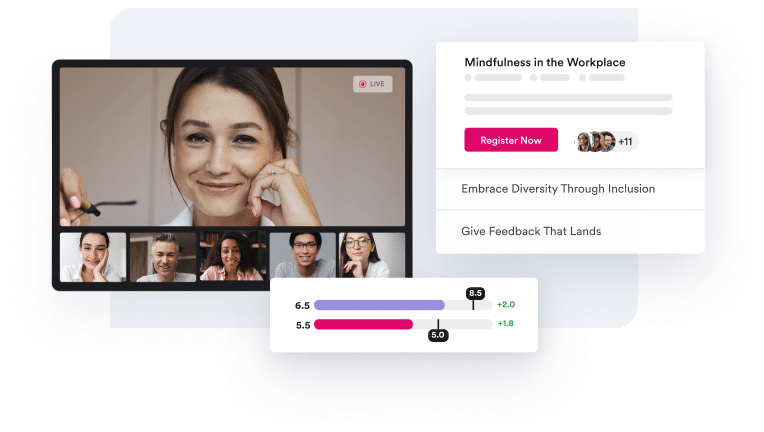Giving and receiving effective feedback is essential to growing professionally and personally. And it’s tricky. The effective feedback can bring out the best performance in a colleague. But, on the other hand, input shared in the wrong environment or with the wrong tone can lead to the recipient becoming defensive, offended, and closed off.
That’s why it’s key for managers to learn how to deliver both positive and negative feedback efficiently properly, and, most importantly, effectively. First, let’s look at why effective feedback matters and how you can give and receive feedback that lands.
Why Effective Feedback Matters
Giving constructive feedback is in managers’ and companies’ best interests. Constructive feedback can motivate individuals to learn more and push them to be the best they can be. When delivered thoughtfully and objectively, Insightful feedback can show people you value them, boost their confidence, and even inspire them to learn and grow.
However, the facts on the ground show that many managers are missing the mark. Studies show that employees who receive feedback regularly are more engaged, productive, and less likely to leave their organizations. Here’s a closer look at the data:
Let’s take a look at the data:
- Employees are hungry for feedback. 68% of employees want more feedback
- Feedback increases productivity. Recognition is the number one thing employees say their manager could give them to inspire them to produce great work. Moreover, 80% of employees report preferring on-the-spot recognition over formal reviews.
- Feedback improves engagement. Of workers that rated themselves as highly engaged, 43% said they received feedback at least once per week.
- Feedback reduces attrition. People who get feedback regularly are more engaged productive and 15% less likely to leave.
The benefits of regular, timely feedback are apparent. Clearly, workers want more feedback, yet 55% of managers think they give enough feedback. Many managers dislike sharing negative feedback with their direct reports and actively put it off until performance reviews or until something balloons up into a more significant issue. In addition, 44% of managers said they find sharing negative feedback difficult and stressful. But, putting off sharing negative feedback can hurt working relationships, hinder an employee’s ability to grow personally and professionally, and can even impact disadvantaged groups unfairly.
It’s better to address an issue early to make employees aware and give them time to fix or improve their behavior. Plus, the more you give (and receive) effective feedback, the easier it becomes. So share your constructive feedback and share it often—your employees will thank you.

How Managers Should Give Effective Feedback
When giving effective feedback, there are four distinct steps to remember. First, you want to remain objective by focusing solely on the situation, their behavior, the impact of their actions, and the way forward. This standard feedback delivery model is called the Situation-Behavior-Impact™ model, or SBI™.
1. Situation
Giving effective feedback as a manager must start with you outlining the specific situation you want to discuss. This is to ensure you understand the context behind the conversation and agree on what occurred or continues to be an ongoing issue. Next, just sure you conduct this conversation at the right place and time, so your employee is more open and receptive to what you have to say. For example, saving your feedback for a private 1-on-1 conversation, rather than after a team meeting when prying ears might be loitering around or your employee might be on edge. 
Here are a few tips to keep in mind when outlining the situation:
- Be Specific. Pick a specific and recent instance to discuss. Anchor your conversation around something that happened recently and that you both remember. Stay away from solely discussing something that happened weeks or months ago. Your memories of that event will probably be less clear, and you might make generalized or accusatory statements that could set your feedback recipient off.
- Avoid Generalizations. Avoid using words like “always,” “often,” and “never,” as these can immediately put your recipient on the defense. Notice the difference in tone between “You are always late for meetings” and “I’ve noticed you’ve been late to our last two team meetings.” The former leaves no room for discussion and generalizes all previous occurrences, while the latter is more open and lays out indisputable facts.
Situation step in action
Instead of:
- “You are always late for meetings.”
- “You never finish the weekly report on time, and I can’t take it anymore.”
Try:
- “You’ve been late to our last two team meetings.”
- “The weekly report has been late the last three weeks.”
The first option uses an all-or-nothing word that may or may not be accurate, whereas the second option is strictly facts: the person has been late to the last two team meetings or in turning in reports, and the manager noticed. That’s all that is needed.
2. Behavior
Next, you’ll want to address the specific behavior you want to discuss. During this step, you must share only what you’ve personally observed and stay as objective as possible. But, again, you don’t want your direct report to become overly offensive, or they will shut out your advice, so state the facts and then move on to the next step of sharing effective feedback: Impact.
- Stick to Observations. When explaining the situation, stick with the facts, what you observed, or what you know explicitly happened. Don’t include hearsay or any unvalidated remarks you heard from someone else, as this can make the recipient think you are taking someone else’s side or don’t trust them. Instead, use statements like “Yesterday, I saw…” or “The last two times we met with the Engineering team, I noticed…” so stick with indisputable, concrete examples that don’t come off as accusatory.
- Stay Objective. Be careful not to inject any of your own assumptions or biases into this part of the discussion. Stick with the facts only. For example, suppose one of your direct reports got into a heated argument with another teammate and stormed off in the middle of a meeting. In that case, you might address their behavior by saying, “It seemed to me you were frustrated in yesterday’s team meeting. I noticed that you left the meeting without discussing the next steps.” If, instead, you shared, “I spoke with Jim after your altercation in the meeting yesterday, and he is feeling very disrespected,” your employee might think you’re siding with Jim since you spoke with him first and start getting overly defensive, killing your shot at sharing effective feedback.
Behavior step in action
Instead of:
- “I am really offended that you . . .”
- “I spoke with Jim after your altercation in the meeting yesterday, and he feels very disrespected.”
Try:
- “It seemed to me you were frustrated in yesterday’s team meeting. But then, I noticed that you left the meeting without discussing the next steps.”
- “Yesterday, I saw….”
- “The last two times we met with the Engineering team, I noticed….”
In this step, we are focusing on the behavior. We are not (yet) talking about the impact of that behavior (that’s the next step). You risk the recipient becoming defensive or debating the validity of emotions by talking about feelings or hearsay before the situation and implications are clear. The first two steps aim to outline an objective reality that you, the recipient, and any disinterested party could agree on.
3. Impact
Next, you should share the broader implications of this specific behavior. For example, share the impact this behavior has on you, your team, your client, the rest of the business, etc. Take this time to explain the scope of the issue and why it’s essential for you both to discuss it now.
- Describe the results of the behavior on the team, business, or you. Everyone comes to work with different experiences. As a manager, you may have additional information, understand the nuances of senior management expectations better, or have an experience that helps you predict what may happen due to certain behaviors. It is important not to assume that everyone has the same knowledge or perspective on the impact of their behavior.
- Share Why This Matters. You need to help the recipient understand why you’re discussing the feedback now and why this issue needs to be resolved promptly. For example, suppose reckless behavior could cost you to lose a client’s business. In that case, if a rogue statement is hurting team morale, a mistaken calculation could jeopardize the success of a project, etc. This shares the gravity of the situation and gives context to why you’re bringing this to light now.
- Ask to Hear Their Side of The Story. Sharing effective feedback is never a one-sided discussion. Once you’ve shared your observations, let them share their perspective. This can also help you discover the intent behind their actions and help you realize if this might be a slight misunderstanding with an easy resolution. Asking questions like “What is your perspective?” and “How does this resonate with your experience?” gives them the floor to share their side of the story and show you’re open to working with them to find a resolution.
Impact step in action
Instead of:
- “Obviously, this is a huge problem, because everyone knows that . . . “
- “You should know by now Frank can’t change the schedule at the last minute.”
- “I can’t believe we have even to discuss this. Clearly, this is a huge disaster that you should have seen coming a mile away.”
Try:
- “I felt frustrated because . . . “
- “As a result of the discussion becoming too heated, we had to adjourn and now will need to schedule another meeting, which pushes back our timeline.”
- “If we keep making last-minute requests of the email marketing team, they won’t prioritize our work, and our campaigns will go out late.”
- “I am bringing this up because . . . “
- “Let me explain why this is important . . .”
Again, we aren’t making assumptions or expecting the other person to infer. We explicitly state the impact, check for understanding, and allow the other person to share their perception. Avoid getting into a debate about whose perception is “correct,” the focus is the impact, so take care not to get derailed.

4. Define The Way Forward
Now that your effective feedback has been heard, it’s time to ensure your conversation inspires change. Next, you’ll want to outline any next steps and come to a resolution with your employee. But, again, this is a collaborative step, and you must get your employee on board to find a lasting and effective answer. After all, if you don’t have their buy-in, odds are any solution you propose will be short-lived.
- Emphasize Finding a Solution. Here’s where your tone comes into play. Try to keep the conversation, and your tone pointed positively to the future. How can you both work together to improve the situation and keep the topic at hand from continuing? Try to frame the conversation around finding and working toward a solution together to avoid putting all the blame or burden on the feedback recipient.
- Regularly Check-in. Once you have come to an understanding or agreed on an improvement plan, schedule a regular check-in to discuss progress or add it to your 1-on-1 meeting agenda. This will not only help you both stay accountable but also help you chat about the situation as it either improves or worsens.
Finally, remember that everyone receives feedback differently. What works for one employee might not necessarily work for another. If specific feedback doesn’t land well with a team member, don’t let the conversation develop into a blame game. Instead, learn from the experience and try a different approach next time. Again, the more you share effective feedback, the easier it will become, so keep practicing, and you’ll get the hang of it in no time.
Define the way forward step in the action
Instead of:
- “Ok, I’ve said my piece. Hopefully, we never have to discuss this again.”
- “The only thing that matters is that the customer was furious; I don’t care what happened.”
- “I’m the boss, and what I say goes; you don’t need to know more than that.”
Try:
- What are your next steps?
- What are your thoughts on moving forward?
- How did this feedback land for you?
- How can I be most helpful as you put this into practice?
The main goal of this step is to look positively toward the future and ensure everyone is on the same page. In addition, by focusing on the recipient’s next steps and ideas, you are driving home the message that acting on the feedback is the employee’s responsibility. Still, you are here to support them in their journey.
Tips for Following Up on Effective Feedback
Once you have come to an understanding or agreed on an improvement plan, following up is critical. Check out these handy tips to ensure your follow-up is effective:
- Schedule a regular check-in to discuss progress or add it to your 1-on-1 meeting agenda. This will not only help you both stay accountable but also help you chat about the situation as it either improves or worsens.
- Follow up with recognition, praise, and acknowledge steps in the right direction. Change and growth don’t happen overnight. So be sure to recognize incremental progress along the way.
- Make yourself available for follow-up questions and challenges. Nothing is worse than being handed a new challenge with no tools, information, or support. Learning something new or changing a behavior can be difficult, so offer help.
- Remember, feedback is never a linear process; it is always a work in progress. If specific feedback doesn’t land, don’t move into a blame game. Instead, learn from it and embrace a different approach.
Finally, remember that everyone receives feedback differently. What works for one employee might not necessarily work for another. If specific feedback doesn’t land well with a team member, don’t let the conversation develop into a blame game. Instead, learn from the experience and try a different approach next time. Again, the more you share effective feedback, the easier it will become, so keep practicing, and you’ll get the hang of it in no time.
I am interested in learning more about how to give and receive effective feedback.
With classes like “Give Feedback That Lands,” you’ll learn a research-backed approach to giving corrective and positive feedback and how to follow up so that effective feedback leads to action. Learn how live online training can help your business and be scaled, delivered, and measured for the any-sized remote or hybrid team.








